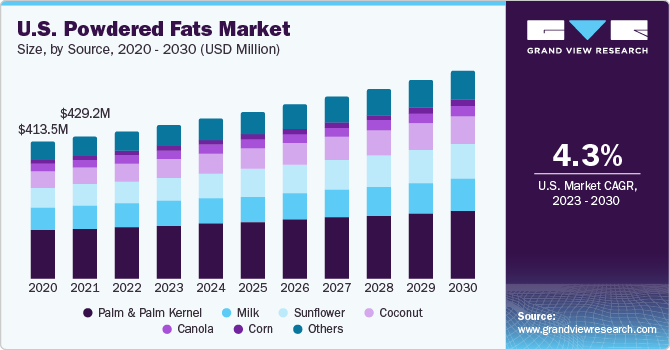Powdered Fats Market Size, Share & Trends Analysis growth rate (CAGR) of 4.4% from 2023 to 2030

The global powdered fats market size was estimated at USD 2.24 billion in 2022 and is projected to grow at a compound annual growth rate (CAGR) of 4.4% from 2023 to 2030. This market is expected to experience significant growth throughout the forecast period, driven by the growing demand for healthier fats in food applications and rising adoption of powdered fats in nutritional product formulations. There is a growth in demand of healthy fats in food industry, particularly in the baked goods market. It is driven by rising consumer preference for indulgent foods that have a plant-based, clean-label profile, low-fat content, and feature organic fats and oils. Consumers are increasingly mindful of their food choices, seeking unique sensory experiences and prioritizing factors like clean labels, plant-based ingredients, nutritional profiles, and sustainability. As a result, there is a rising interest in powdered fats, especially those derived from sought-after oils like sunflower and coconut.
The 2020 Dietary Guidelines for Americans emphasized reducing trans fats and limiting saturated fats, promoting plant-based oils like canola, corn, and soybean. According to a 2021 FATitudes survey by Cargill, consumers increasingly monitor fats and oils in packaged foods, with 53% of Americans being vigilant about their choices. According to an ADM Outside Voice proprietary research in 2021, clean-label products are in demand, with 69% of consumers preferring simple, recognizable ingredients.
Request a free sample copy or view report summary:
Prominent end-uses in the market include dairy and non-dairy products, bakery & confectionery, frozen desserts, infant formula, nutraceutical supplements, nutritional beverages, instant beverages, seasonings, sauces, and dips. The use of powdered fats in various applications is driven by their versatility and convenience. In the dairy industry, powdered fats enhance shelf stability by resisting oxidation and rancidity, ensuring long-lasting dairy products. The demand for dairy products, both traditional and non-dairy alternatives, remains high, fueling the use of powdered fats in products like cheese, ice creams, and non-dairy creamers. In response to the rising popularity of plant-based options, powdered fats from sources like coconut oil are utilized in non-dairy creamers to meet the demand for lactose-free and plant-based products.
Spray drying, drum drying, freeze drying, encapsulation, and fluidized bed drying are the commonly used processing techniques for powdered fat manufacturing. Spray drying is one of the main manufacturing methods in the industry. This method is suitable for heat-sensitive fats. Spray dried powdered fats are used in various food products, including bakery items, confectionery, instant beverages, dairy alternatives, savory foods, and nutritional supplements. The process removes moisture from the fat source, extending the shelf life of the end products.






